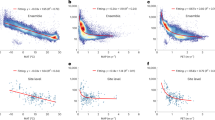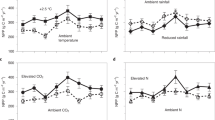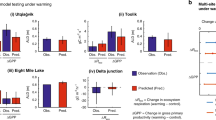Abstract
Feedbacks between the terrestrial carbon cycle and climate change could affect many ecosystem functions and services, such as food production, carbon sequestration and climate regulation. The rate of climate warming varies on diurnal and seasonal timescales. A synthesis of global air temperature data reveals a greater rate of warming in winter than in summer in northern mid and high latitudes, and the inverse pattern in some tropical regions. The data also reveal a decline in the diurnal temperature range over 51% of the global land area and an increase over only 13%, because night-time temperatures in most locations have risen faster than daytime temperatures. Analyses of satellite data, model simulations and in situ observations suggest that the impact of seasonal warming varies between regions. For example, spring warming has largely stimulated ecosystem productivity at latitudes between 30° and 90° N, but suppressed productivity in other regions. Contrasting impacts of day- and night-time warming on plant carbon gain and loss are apparent in many regions. We argue that ascertaining the effects of non-uniform climate warming on terrestrial ecosystems is a key challenge in carbon cycle research.
This is a preview of subscription content, access via your institution
Access options
Subscribe to this journal
Receive 12 print issues and online access
$259.00 per year
only $21.58 per issue
Buy this article
- Purchase on Springer Link
- Instant access to full article PDF
Prices may be subject to local taxes which are calculated during checkout






Similar content being viewed by others
References
Luo, Y. Q. Terrestrial carbon-cycle feedback to climate warming. Annu. Rev. Ecol. Evol. 38, 683–712 (2007).
Melillo, J. M. et al. Soil warming and carbon-cycle feedbacks to the climate system. Science 298, 2173–2176 (2002).
Rustad, L. E. et al. A meta-analysis of the response of soil respiration, net nitrogen mineralization, and aboveground plant growth to experimental ecosystem warming. Oecologia 126, 543–562 (2001).
Schmidt, I. K., Jonasson, S., Shaver, G. R., Michelsen, A. & Nordin, A. Mineralization and distribution of nutrients in plants and microbes in four arctic ecosystems: responses to warming. Plant Soil 242, 93–106 (2002).
Harte, J. et al. Global warming and soil microclimate—results from a meadow-warming experiment. Ecol. Appl. 5, 132–150 (1995).
Piao, S., Friedlingstein, P., Ciais, P., Viovy, N. & Dmarty, J. Growing season extension and its impact on terrestrial carbon cycle in the Northern Hemisphere over the past 2 decades. Glob. Biogeochem. Cycles 21, GB3018 (2007).
Schwartz, M., Ahas, R. & Aasa, A. Onset of spring starting earlier across the Northern Hemisphere. Glob. Change Biol. 12, 343–351 (2006).
Harte, J. & Shaw, R. Shifting dominance within a montane vegetation community—results of a climate-warming experiment. Science 267, 876–880 (1995).
Flannigan, M. D., Stocks, B. J. & Wotton, B. M. Climate change and forest fires. Sci. Total Environ. 262, 221–229 (2000).
Falvey, M. & Garreaud, R. D. Regional cooling in a warming world: Recent temperature trends in the southeast Pacific and along the west coast of subtropical South America (1979–2006). J. Geophys. Res. Atmos. 114, 04102 (2009).
Xu, L. et al. Temperature and vegetation seasonality diminishment over northern lands. Nature Clim. Change 3, 581–586 (2013).
Serreze, M. C. & Barry, R. G. Processes and impacts of Arctic amplification: A research synthesis. Global Planet. Change 77, 85–96 (2011).
Mamtimin, B. et al. Recent trends of temperature change under hot and cold desert climates: Comparing the Sahara (Libya) and Central Asia (Xinjiang, China). J. Arid Environ. 75, 1105–1113 (2011).
Easterling, D. et al. Maximum and minimum temperature trends for the globe. Science 277, 364 (1997).
Zhou, L. M. et al. Spatiotemporal patterns of changes in maximum and minimum temperatures in multi-model simulations. Geophys. Res. Lett. 36, L02702 (2009).
Sheffield, J., Goteti, G., Wood, E. F. Development of a 50-year high-resolution global dataset of meteorological forcings for land surface modeling. J. Clim. 19, 3088–3111 (2006).
Kowalczyk, E. A. et al. The CSIRO Atmosphere Biosphere Land Exchange (CABLE) model for use in climate models and as an offline model. (CSIRO Marine and Atmospheric Research Paper 013) (CSIRO Marine and Atmospheric Research, 2006).
Taylor, K. E., Stouffer, R. J. & Meehl, G. A. An overview of CMIP5 and the experiment design. Bull. Am. Meteor. Soc. 93, 485–498 (2012).
Menzel, A. et al. European phenological response to climate change matches the warming pattern. Global Change Biol. 12, 1969–1976 (2006).
Wolkovich, E. M. et al. Warming experiments underpredict plant phenological responses to climate change. Nature 485, 494–497 (2012).
Dieleman, W. I. et al. Simple additive effects are rare: a quantitative review of plant biomass and soil process responses to combined manipulations of CO2 and temperature. Global Change Biol. 18, 2681–2693 (2012).
Lin, D. L., Xia, J. Y. & Wan, S. Q. Climate warming and biomass accumulation of terrestrial plants: a meta-analysis. New Phytol. 188, 187–198 (2010).
Niu, S. L. et al. Water-mediated responses of ecosystem carbon fluxes to climatic change in a temperate steppe. New Phytol. 177, 209–219 (2008).
Bauerle, W. L. et al. Photoperiodic regulation of the seasonal pattern of photosynthetic capacity and the implications for carbon cycling. Proc. Natl Acad. Sci. USA 109, 8612–8617 (2012).
Piao, S. L. et al. Net carbon dioxide losses of northern ecosystems in response to autumn warming. Nature 451, 49–U43 (2008).
Vesala, T. et al. Autumn temperature and carbon balance of a boreal Scots pine forest in Southern Finland. Biogeosciences 7, 163–176 (2010).
Fitzhugh, R. D. et al. Effects of soil freezing disturbance on soil solution nitrogen, phosphorus, and carbon chemistry in a northern hardwood ecosystem. Biogeochemistry 56, 215–238 (2001).
Hobbie, S. E. & Chapin, F. S. Winter regulation of tundra litter carbon and nitrogen dynamics. Biogeochemistry 35, 327–338 (1996).
Monson, R. K. et al. Winter forest soil respiration controlled by climate and microbial community composition. Nature 439, 711–714 (2006).
Kreyling, J. Winter climate change: a critical factor for temperate vegetation performance. Ecology 91, 1939–1948 (2010).
Richardson, A. D. et al. Influence of spring and autumn phenological transitions on forest ecosystem productivity. Phil. Trans. R. Soc. Lond. B Biol. Sci. 365, 3227–3246 (2010).
Chapin, F. S., Shaver, G. R., Giblin, A. E., Nadelhoffer, K. J. & Laundre, J. A. Responses of arctic tundra to experimental and observed changes in climate. Ecology 76, 694–711 (1995).
Arnone, J. A. et al. Prolonged suppression of ecosystem carbon dioxide uptake after an anomalously warm year. Nature 455, 383–386 (2008).
Sherry, R. A. et al. Lagged effects of experimental warming and doubled precipitation on annual and seasonal aboveground biomass production in a tallgrass prairie. Global Change Biol. 14, 2923–2936 (2008).
Concilio, A., Chen, J. Q., Ma, S. & North, M. Precipitation drives interannual variation in summer soil respiration in a Mediterranean-climate, mixed-conifer forest. Clim. Change 92, 109–122 (2009).
Groffman, P. M. et al. Colder soils in a warmer world: A snow manipulation study in a northern hardwood forest ecosystem. Biogeochemistry 56, 135–150 (2001).
Xia, J. & Wan, S. Global response patterns of terrestrial plant species to nitrogen addition. New Phytol. 179, 428–439 (2008).
Ciais, P. et al. Europe-wide reduction in primary productivity caused by the heat and drought in 2003. Nature 437, 529–533 (2003).
Angert, A. et al. Drier summers cancel out the CO2 uptake enhancement induced by warmer springs. Proc. Natl Acad. Sci. USA 102, 10823–10827 (2005).
Zhou, L. et al. Variations in northern vegetation activity inferred from satellite data of vegetation index during 1981 to 1999. J. Geophys. Res. 106, 20069–20083 (2001).
Gurney, K. et al. Towards robust regional estimates of CO2 sources and sinks using atmospheric transport models. Nature 415, 626–630 (2002).
Forbes, B. C., Fauria, M. & Zetterberg, P. Russian Arctic warming and 'greening' are closely tracked by tundra shrub willows. Global Change Biol. 16, 1542–1554 (2010).
Koven, C. D. Boreal carbon loss due to poleward shift in low-carbon ecosystems. Nature Geosci. 6, 452–456 (2013).
Koven, C. D. et al. Permafrost carbon-climate feedbacks accelerate global warming. Proc. Natl Acad. Sci. USA 108, 14769–14774 (2011).
MacDougall, A. H., Avis, C. A. & Weaver, A. J. Significant contribution to climate warming from the permafrost carbon feedback. Nature Geosci. 5, 719–721 (2012).
Spahni, R., Joos, F., Stocker, B. D., Steinacher, M. & Yu, Z. C. Transient simulations of the carbon and nitrogen dynamics in northern peatlands: from the Last Glacial Maximum to the 21st century. Clim. Past 9, 1287–1308 (2013).
Koven, C. D., Riley, W. J. & Stern, A. Analysis of permafrost thermal dynamics and response to climate change in the CMIP5 Earth System Models. J. Clim. 26, 1877–1900 (2013).
Cox, P. et al. Increasing risk of Amazonian drought due to decreasing aerosol pollution. Nature 453, 212–215 (2008).
Friedlingstein, P. et al. Climate-carbon cycle feedback analysis: Results from the C4MIP model intercomparison. J. Clim. 19, 3337–3353 (2006).
Bonebrake, T. C. & Mastrandrea, M. D. Tolerance adaptation and precipitation changes complicate latitudinal patterns of climate change impacts. Proc. Natl Acad. Sci. USA 107, 12581–12586 (2010).
Huey, R. B. & Tewksbury, J. J. Can behavior douse the fire of climate warming? Proc. Natl Acad. Sci. USA 106, 3647–3648 (2009).
Tewksbury, J. J., Huey, R. B. & Deutsch, C. A. Ecology—Putting the heat on tropical animals. Science 320, 1296–1297 (2008).
Loarie, S. R. et al. The velocity of climate change. Nature 462, 1052–1055 (2009).
Peterson, D. L., Schreiner, E. G. & Buckingham, N. M. Gradients, vegetation and climate: spatial and temporal dynamics in the Olympic mountains, USA. Glob. Ecol. Biogeogr. 6, 7–17 (1997).
Bertrand, R. et al. Changes in plant community composition lag behind climate warming in lowland forests. Nature 479, 517–520 (2011).
Turnbull, M., Murthy, R. & Griffin, K. The relative impacts of daytime and night-time warming on photosynthetic capacity in Populus deltoides. Plant Cell Environ. 25, 1729–1737 (2002).
Alward, R. D., Detling, J. K. & Milchunas, D. G. Grassland vegetation changes and nocturnal global warming. Science 283, 229–231 (1999).
Dhakhwa, G. & Campbell, C. Potential effects of differential day-night warming in global climate change on crop production. Clim. Change 40, 647–667 (1998).
Peng, S. et al. Asymmetric effects of day and night-time warming on Northern Hemispheric vegetation. Nature 501, 88–92 (2013).
Wan, S., Xia, J., Liu, W. & Niu, S. Photosynthetic over-compensation under nocturnal warming enhances grassland carbon sequestration. Ecology 90, 2700–2710 (2009).
Atkin, O. K. & Tjoelker, M. G. Thermal acclimation and the dynamic response of plant respiration to temperature. Trends Plant Sci. 8, 343–351 (2003).
Armstrong, A. F., Logan, D. C. & Atkin, O. K. On the developmental dependence of leaf respiration: responses to short-and long-term changes in growth temperature. Am. J. Bot. 93, 1633–1639 (2006).
Reich, P. B. The carbon dioxide exchange. Science 329, 774–775 (2010).
Cardon, Z. G. & Gage, D. J. Resource exchange in the rhizosphere: molecular tools and the microbial perspective. Annu. Rev. Ecol. Evol. Syst. 37, 459–488 (2006).
Zhang, N. et al. Soil microbial community changes and their linkages with ecosystem carbon exchange under asymmetrically diurnal warming. Soil Biol. Biochem. 43, 2053–2059 (2011).
Korner, C. Carbon limitation in trees. J. Ecol. 91, 4–17 (2003).
Xia, J., Han, Y., Zhang, Z., Zhang, Z. & Wan, S. Effects of diurnal warming on soil respiration are not equal to the summed effects of day and night warming in a temperate steppe. Biogeoscience 6, 1361–1370 (2009).
Phillips, C. L., Gregg, J. W., Wilson, J. K. Reduced diurnal temperature range does not change warming impacts on ecosystem carbon balance of Mediterranean grassland mesocosms. Global Change Biol. 17, 3263–3273 (2011).
Thornley, J. H. M. & Cannell, M. G. R. Modelling the components of plant respiration: Representation and realism. Ann. Bot. 85, 55–67 (2000).
Muller, B. et al. Water deficits uncouple growth from photosynthesis, increase C content, and modify the relationships between C and growth in sink organs. J. Exp. Bot. 62, 1715–1729 (2011).
Hoch, G. & Korner, C. Global patterns of mobile carbon stores in trees at the high-elevation tree line. Global Ecol. Biogeogr. 21, 861–871 (2012).
Rocha, A. V., Goulden, M. L., Dunn, A. L. & Wofsy, S. C. On linking interannual tree ring variability with observations of whole-forest CO2 flux. Global Change Biol. 12, 1378–1389 (2006).
Webb III, T. & Bartlein, P. Global changes during the last 3 million years: climatic controls and biotic responses. Annu. Rev. Ecol. Syst. 23, 141–173 (1992).
Niu, S. et al. Thermal optimality of net ecosystem exchange of carbon dioxide and underlying mechanisms. New Phytol. 194, 775–783 (2012).
Osmond, B. et al. Changing the way we think about global change research: scaling up in experimental ecosystem science. Global Change Biol. 10, 393–407 (2004).
Luo, Y. et al. A framework of benchmarking land models. Biogeosciences 9, 1899–1944 (2012).
Sitch, S. et al. Evaluation of ecosystem dynamics, plant geography and terrestrial carbon cycling in the LPJ dynamic global vegetation model. Global Change Biol. 9, 161–185 (2003).
Chou, W. W. et al. The sensitivity of annual grassland carbon cycling to the quantity and timing of rainfall. Global Change Biol. 14, 1382–1394 (2008).
Mack, M. C. et al. Carbon loss from an unprecedented Arctic tundra wildfire. Nature 475, 489–492 (2011).
Bokhorst, S. F., Bjerke, J. W., Tømmervik, H., Callaghan, T. V. & Phoenix, G. K. Winter warming events damage sub-Arctic vegetation: consistent evidence from an experimental manipulation and a natural event. J. Ecol. 97, 1408–1415 (2009).
Braswell, B. H. et al. The response of global terrestrial ecosystems to interannual temperature variability. Science 278, 870–872 (1997).
Mahlstein, I, Daniel, J. S. & Solomon, S. Pace of shifts in climate regions increases with global temperature. Nature Clim. Change 3, 739–743 (2013).
Acknowledgements
We wish to thank Ivan Janssens for his valuable suggestions on the manuscript, Yingping Wang for help with modelling simulations, Lisa Delp Taylor for polishing the language, and Jinwei Dong for his comments on mapping the results. This study was financially supported by the Ministry of Science and Technology (2013CB956300), the National Natural Science Foundation of China (41030104, 30925009), and the International Center for Ecology, Meteorology and Environment of Nanjing University of Science and Technology.
Author information
Authors and Affiliations
Contributions
S.W., J.C. and J.X. designed the study. J.X. performed the analyses. J.X., S.W., J.C., S.P. and P.C. drafted the paper. Y.L. contributed to the interpretation of the results and analytical tools. All authors contributed extensively to the revisions of the manuscript.
Corresponding author
Ethics declarations
Competing interests
The authors declare no competing financial interests.
Supplementary information
Supplementary Information
Supplementary Information (PDF 4386 kb)
Rights and permissions
About this article
Cite this article
Xia, J., Chen, J., Piao, S. et al. Terrestrial carbon cycle affected by non-uniform climate warming. Nature Geosci 7, 173–180 (2014). https://doi.org/10.1038/ngeo2093
Received:
Accepted:
Published:
Issue Date:
DOI: https://doi.org/10.1038/ngeo2093
This article is cited by
-
Decadal-scale variability and warming affect spring timing and forest growth across the western Great Lakes region
International Journal of Biometeorology (2024)
-
Non-summer hydrothermal conditions controlling tree growth in north subtropical China are closely related to AMO and PDO
Trees (2024)
-
Temperature fluctuation promotes the thermal adaptation of soil microbial respiration
Nature Ecology & Evolution (2023)
-
Quantifying the grapevine xylem embolism resistance spectrum to identify varieties and regions at risk in a future dry climate
Scientific Reports (2023)
-
Moisture-dependent response of soil carbon mineralization to temperature increases in a karst wetland on the Yunnan-Guizhou Plateau
Environmental Science and Pollution Research (2023)



